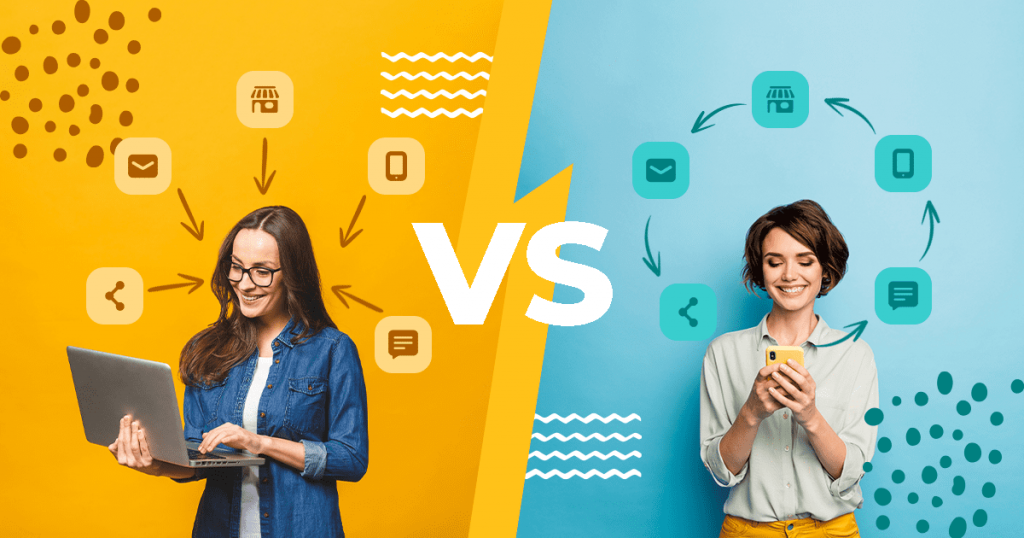You may have noticed that the expectations of customers have changed over the years.
They are looking for ways in which they can interact with brands of interest across various channels and platforms.
Due to these expectations, businesses must be ready to engage with their customers across various channels.
There are two different strategies that businesses can take when doing this. One offers a bit more consistency and customer focus than the other. These are omnichannel and multichannel approaches.
Now, omnichannel and multichannel are two very popular terms that are used in the business and marketing industries.
Unfortunately, many people haven’t quite captured the differences between the two. In fact, they are sometimes used interchangeably, even though they are two individual strategies with different focuses.
Below, you will learn about both omnichannel vs multichannel, what distinguishes them from one another, and which approach is better when it comes to the overall customer experience.
What Does Multichannel Mean?
Multichannel basically refers to the use of multiple channels to market, which is imperative considering the fact that consumers are constantly moving between channels.
While there may be more than one channel being used, they are not integrated with one another at all.
For instance, a billboard and a company website are two separate channels that are not directly connected to one another, but they are both used to increase brand awareness.
As a general rule, businesses will focus on the creation of strategies based on each individual channel that will make the process easy and engaging for customers.
Basically, the end game is to engage with the customer on the right channel and at the right time with the right message.
Focusing on customer engagement through multiple channels is critical to the success of a brand, as it is often the most effective (sometimes only) way to reach prospects and remain competitive today.
What Does Omnichannel Mean?
With omnichannel, multiple channels are still used to communicate information about a brand to customers.
However, these channels are integrated so that the customer has a seamless user experience. It is often referred to as an all-channel approach.
So, what does that mean exactly? Simply put, it means that a customer can move from one channel to the next and pick up right where they previously left off on another channel.
Therefore, this approach is beneficial when you consider the fact that most consumers will move from one channel and/or device to another throughout the day.
For instance, let’s say that a customer begins a live chat with a call center representative. Because of the nature of the customer’s issue, the live chat is escalated to a video chat.
These are two separate channels, but as they are integrated, the customer doesn’t need to repeat any information already shared within the live chat.
Omnichannel vs Multichannel: What Is the Difference?
While there are indeed similarities between omnichannel and multichannel, which is why the lines between the two approaches can often get blurred, the differences exist primarily within the final experience that the customer has.
As you’ve learned from each definition, omnichannel integrates multiple channels for users to have a seamless experience across the entire board, whereas multichannel features no integration and focuses on customer engagement.
Here are a few more things that will help you tell the difference between the two approaches.
Customer Engagement vs. Customer Experience
The primary goal of a multichannel strategy is to make it possible for prospects to reach your brand on numerous channels.
The primary focus of this approach is to use the channels to the brand’s advantage in terms of customer engagement by casting a wide net. Ultimately, the more engagement with customers, the better.
However, the ultimate goal of an omnichannel approach is to focus more on the actual customer.
In other words, this approach works to develop stronger relationships with customers via a process that aims to connect channels for a seamless user experience.
Let’s look at an example of this for an enhanced understanding of the concept.
On social media, a multichannel strategy would focus on gaining more followers, likes, comments, and shares on your brand’s page and posts. These metrics will show that more people are actively engaging with your brand.
On the other hand, an omnichannel strategy focuses less on quantitative metrics and more on ensuring that customers can go from your social media page to your website without losing anything in the process.
For instance, if a user clicks on a Facebook advertisement, they will be taken directly to that product/service as opposed to the home page of your website where they would need to locate the necessary information.
This ultimately provides the customer with a smooth, superior experience.
Personalized Experience
The multichannel approach puts an emphasis on sharing the message of a brand with customers.
The goal of this is to hopefully get that customer to take action and complete a call-to-action (CTA).
The problem with this is that many of these messages are generic in content, limiting the amount of personalization offered to the customer.
Now, while the omnichannel approach does the exact same, it is a little different. Since this strategy aligns the different channels, it focuses on the best possible customer experience that can be obtained by collecting customer data and using it to understand each and every customer in a better light.
In the end, this allows your company to gain beneficial insights into what customers are looking for in regard to their demographics, preferences, lifestyle, pain points, etc.
You can use this data to find out why a customer may have abandoned their cart, allowing you to customize your products/services, marketing strategy, and everything in between specifically to the taste of your customer.
By understanding customers and utilizing data for a more customized experience, the ultimate goal is to provide cohesive customer engagement and a seamless, effortless user experience.
Consistency
The multichannel strategy will approach each channel on its own.
Therefore, there is no integration, which means it can result in not only an inconsistent but also a frustrating experience for customers across all channels being used.
Due to being unable to switch between channels seamlessly, some customers may choose a brand that offers the omnichannel user experience.
This is a far more consistent and customized experience across the entire board. It also helps to create a unified brand image and user experience, which further helps in the building of familiarity and trust.
Omnichannel vs Multichannel: Which Is Better?
A positive user experience is critical to the overall success of a business, and because of this, it should be made a priority.
When you have this in mind, it means that an omnichannel approach is superior.
This type of approach ensures customers have a seamless experience across all channels used, as customers want things that are easy for them. They don’t want to have to put in extra effort.
Opting for the omnichannel strategy means that you will need to put in some work to ensure that all of your channels are synced with one another, as well as your CRM.
However, this doesn’t mean that your brand shouldn’t use the multichannel approach. In many cases, this strategy may be better for your business.
This is true for brick-and-mortar businesses that are going digital. Since these companies would need to start from the ground and build their online presence, a simple strategy like the multichannel approach may be ideal.
Of course, at the same time, due to the potential ROI that transitioning to the omnichannel strategy can have, even physical stores should consider putting in the effort to implement this strategy.
Wrap Up
Both omnichannel and multichannel strategies have their benefits, but the omnichannel approach tends to offer more benefits tailored to the customer.
Some of these benefits include improved brand awareness, conversions, customer loyalty, and customer retention.
An online presence is just not enough to be successful and keep customers happy. Instead, a seamless experience is desired by customers.
Because of this, businesses should seriously consider adopting an omnichannel approach to meet and exceed customer expectations.
As you work toward developing the best strategy that will work effectively for your brand, don’t overlook the importance of the content experience, which will further engage your customers and provide them with the best possible user experience.
Read all about it in our blog post!




![[ROCK NA] [EBOOK SEO] Complete Guide](https://rockcontent.com/wp-content/uploads/2024/06/banner_Search-Engine-Optimization.png)






